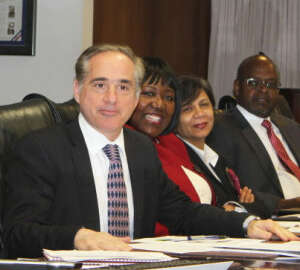
Federal unions tell agencies, partner with us for a more engaged workforce
When labor-management relationships are strong, employee engagement improves, federal union leaders said during a discussion at the Federal Mediation and...
CHICAGO — For many federal union leaders, the relationships they’ve worked to rebuild between their organizations and agency management have slowly improved over the last eight years.
But union leaders said they’re looking for more out of an executive order, signed by President Barack Obama in 2009, which established a formal partnership between federal unions and agency management and created the Council on Federal Labor Management Relations.
“We’ve sort of had a roller coaster ride with labor management relationships,” said J. David Cox, national president of the American Federation of Government Employees at the FMCS National Labor Management Conference in Chicago Aug. 17. “I wouldn’t say it’s been like the Clinton years or the Bush years. I’d say it’s been more like a mixture of those two years that we have seen in labor relations.”
Obama re-signed the memo after President George W. Bush repealed the order that his predecessor signed in 1993.
Union leaders acknowledged that the future of labor-management relations next year will likely depend on the incoming administration and president, whoever that might be. And they expressed some frustration that successful union-agency partnerships too often depended on the political whims of the current administration, when developing partnerships between federal unions and agency management should be common sense.
“It has to make sense at the top, not just at the president’s level but every secretary, every department head, every agency head, every center director,” said Greg Junemann, president of the International Federation of Professional and Technical Engineers. “It has to be driven at the top, where the people who make decisions will show up at the partnership meetings to engage with their workforce and to make sure this is done.”
Union leaders said they want more accountability measures — provisions that make sure agency leaders actually work with federal unions — built in to partnership executive orders in the future.
The current executive order doesn’t have teeth, Junemann said. His members, which work in both the public and private sector, said agency managers need incentives to make sure they’re following the provisions in the executive order.
“Accountability has to happen,” said Tony Reardon, national president of the National Treasury Employees Union. “If there’s no accountability, it’s just not going to work and we’ve seen that.”
Bill Dougan, president of the National Federation of Federal Employees, said agencies need to truly see the value in working with union leadership first if they want the themes of Obama’s executive order to live beyond his administration.
“We have to share a belief that we’re more effective and efficient in accomplishing the mission of the agency when we work in partnership,” Dougan said. “If we don’t believe in that, partnership is not going to work. It’s not going to be sustained.”
When labor-management relationships are strong, employee engagement improves, Reardon said.
He said he’s watched agency managers at the Federal Deposit Insurance Corporation work with his organization to develop a workplace excellence program for FDIC employees. Reardon said it’s because of the collaborative work FDIC leaders and NTEU have done that has helped the agency earn it’s number one ranking among mid-size organizations on the 2015 Federal Employee Viewpoint Survey.
Councils at NTEU also look at the results of the Federal Employee Viewpoint Survey each year and reach out to agency employees to gather more feedback. They use that information to work with the agencies to develop workplace initiatives, which cover issues with training, communication, professional development and job rotations.
“Where the disconnect comes in, where the problem is, is that year after year after year they take the survey, and nothing is really done with that data to change any outcomes or the way things are done in the workplace,” he said. “The next logical question for all of us is, where’s the disconnect?”
Roughly 60 percent of the federal workforce, or 1.2 million employees, belong to a collective bargaining unit, according to Beth Cobert, acting director of the Office of Personnel Management. She said she’s recognized the value of working with federal unions during the aftermath of the OPM breach last summer.
Sponsored Content: How secure is your network? Share your opinions in a Federal News Radio survey.
“We were trying to understand how we could best reach federal employees and communicate in ways that they understand, because it was complicated and it made a little nervous,” Cobert said. “We also had great collaboration with all of your teams.”
OPM asked the federal unions to give feedback and suggestions on the informational sites the agency developed to communicate with federal employees about the cyber breach, she said.
Involving employees in those decisions before they happen, is key to foster a better engaged — and more productive — federal workforce.
“It’s a way to engage the workforce,” Dougan said. “They become engaged, they become empowered. We see transformational things happening in agencies where you have an engaged and an empowered workforce.”
Copyright © 2025 Federal News Network. All rights reserved. This website is not intended for users located within the European Economic Area.
Nicole Ogrysko is a reporter for Federal News Network focusing on the federal workforce and federal pay and benefits.
Follow @nogryskoWFED





